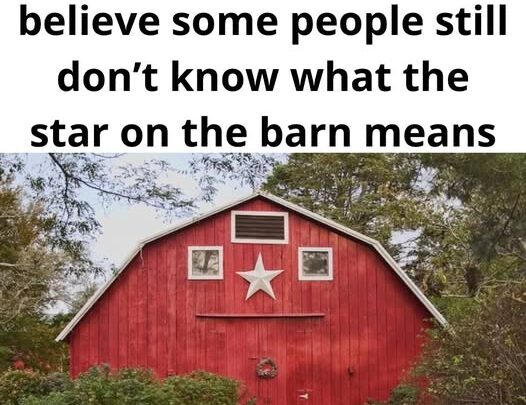Uncategorized
Why Barns Have Stars: Exploring Their History and Symbolic Meaning

If you’ve ever driven down a quiet country road and noticed a large, five-pointed star on the side of a barn, you might have wondered what it means. These beautiful symbols—often called barn stars, Amish stars, or hex signs—have a deeper story than most people realize. They’re not just rustic decorations. They’re pieces of American history, passed down through generations, filled with meaning, tradition, and craftsmanship.
The tradition of barn stars dates back to the 18th and 19th centuries, when Pennsylvania Dutch farmers, descendants of German settlers, began painting or hanging stars on their barns. To them, the star was more than art—it was a charm of protection, believed to bring good luck, prosperity, and safety to their land, crops, and animals.
These early farmers believed that symbols had power, and that decorating a barn with the right sign could invite blessings from nature while warding off misfortune. In a time when life depended on weather, soil, and harvests, even small rituals held deep meaning.
But what many don’t know is that every color of a barn star carried its own message:
-
Red represented good fortune, strength, and vitality.
-
Blue stood for peace, calm, and spiritual protection.
-
Green symbolized growth, fertility, and renewal.
-
Black was a color of protection and warding off evil.
-
White expressed purity, light, and hope.
Some of the most detailed versions of these stars included hex sign patterns, intricate circular designs made up of geometric shapes—almost like mandalas. These patterns were thought to amplify the power of the star, adding layers of symbolism connected to harmony, prosperity, and family unity.
As time passed, the practical and spiritual meanings behind barn stars began to blend with artistry and identity. Farmers started to use these stars as marks of craftsmanship—a way to show pride in their farms and families. Each design became a personal statement, reflecting the values and stories of those who lived and worked beneath them.
By the late 19th century, these stars were no longer just charms—they had become folk art, deeply tied to the soul of rural America. Walking through small farming towns, you could tell a lot about a family’s history and beliefs just by the star hanging above their barn door.
Even though modern farming no longer revolves around superstition, the stars have never disappeared. In fact, they’ve found new life beyond the countryside. Today, you can see barn stars hanging not only on old wooden barns but also on modern homes, patios, and gardens.
People still feel drawn to them—not because they believe they’ll bring luck or protection, but because they evoke nostalgia, simplicity, and connection. For many, a barn star represents a link to their grandparents’ way of life, to open skies and honest work, and to a time when everything—from tools to symbols—was made with care and purpose.
There’s something grounding about that. In a fast-paced world where everything changes so quickly, a weathered metal star on a wall reminds us of continuity—of roots that run deep. It’s a quiet symbol of pride, endurance, and the human desire to leave a mark that outlasts us.
Next time you’re driving through a small town and spot one of those old barn stars glinting in the sunlight, take a second look. Behind its simple shape lies centuries of belief, hope, and creativity. It’s a reminder that beauty and meaning often live in the humblest of places—painted on wooden walls, crafted by calloused hands, and carried forward by those who still believe in the power of tradition.
So no, it’s not just a decoration. It’s a story—a story of faith, family, and the timeless human wish for good fortune and protection.
And whether you hang one for luck, beauty, or nostalgia, every barn star continues to shine with the same message it carried centuries ago:
“This is home, this is our legacy, and may it always stand strong.”
Disclaimer: All stories published on this website are for entertainment and storytelling purposes only. They do not have an identified author and are not claimed to be based on real events or people. Any resemblance to actual persons or events is purely coincidental.



